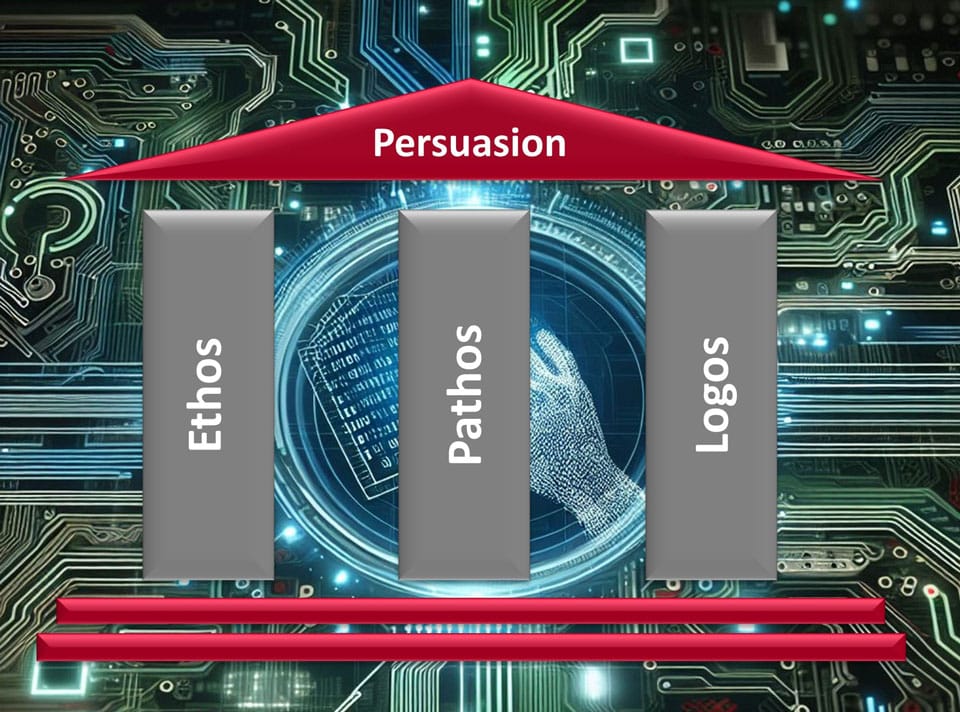Persuasion: Logos, Ethos, and Pathos in the Data-Driven Digital Age

“Don’t raise your voice, improve your argument.” – Desmond Tutu
Martin Luther King delivered one of the most cited persuasive speeches on August 28, 1963. Now called the “I Have a Dream” speech, King threw away the second part of his prepared speech and launched into an impromptu delivery that won the hearts and minds of his followers, made those who had the power to change things take notice, and achieved his goals of desegregation, redress of constitutional rights violations, and expansion of federal works program.
In recent history, the former New Zealand Prime Minister, Jacinda Ardern, persuaded millions of citizens to follow government guidelines to contain the pandemic. She did so by being compassionate and not talking down to the people.
The Greek philosopher Aristotle gave us three elements of successful persuasion—Ethos (character), Logos (logic), and Pathos (emotion)—in his work “Rhetoric,” dating from the 4th century BCE.
In the modern world, persuasion still requires ethos and pathos, with logos made infinitely powerful by data science.
Using Ethos and Pathos
- Demonstrate Authenticity
“A man is wise who does three things: first, he does by himself those things which he advises others to do; secondly, he does not do anything that contravenes the truth; and thirdly, he is patient with the weaknesses of those who surround him.” – Leo Tolstoy, A Calendar of WisdomPersuading people is a breeze when you walk the talk. Nothing is better than seeing someone who believes in what they are trying to convince you to do so but actually does it.
Vineet Nayar, former CEO of HCL Technologies, is a prime example of someone whose actions demonstrate this. The 2010 Harvard Business Review (HBR) article, “Leadership Lessons from India,” says, “He led the charge that gave rise to the company’s bracing motto, “Employee first, customer second”—an idea that would give many managers hives. And he invited employees to evaluate their bosses and their bosses’ bosses; then he posted his own review on the firm’s intranet for all to see, and urged others to follow his lead.”
The article adds, “he sought enough ‘transparency’ and ’empowerment’ in the company that ‘decisions would be made at the points where the decisions should be made’—that is, by employees, where the company meets the client.”
- Establish Trust
“Trust has three core drivers: authenticity, logic, and empathy.” – Frances Frei and Anne MorrissAt one time or another, we all deal with an over-enthusiastic salesperson. Despite them trying very hard, you don’t give in. The reason? You don’t believe them. You won’t be persuaded if you don’t trust someone, no matter what they say.
Sharing your experiences and expertise truthfully, communicating your thoughts with clarity, understanding your audience’s pulse, crafting your message appropriately, and honoring your commitments are all ways to develop trust in those you want to persuade.
Consistency in your behavior removes surprises and makes you trustworthy. People know what to expect from you.
Listening with intention and empathizing with those you are trying to influence is critical to creating trust. When you show sincere care, the relationship is strengthened, and the feeling of trust is deepened.
- Speak the Language of Your Audience
Communication is a significant factor in persuasion. Good communication requires knowing your audience and “speaking their language.” Sometimes, it might be the vernacular of your audience.We all have heard of the warm reception Jaqueline Kennedy received when she and President Kennedy visited France, and she spoke French, which prompted President Kennedy to say, “I do not think it altogether inappropriate to introduce myself… I am the man who accompanied Jacqueline Kennedy to Paris, and I have enjoyed it.”
Knowing your audience requires you to research their composition (demographics) and dispositions, empathize, and craft your message so that it would be received enthusiastically.
Using Logos – The Power Data
- Use Data to Establish Credibility
Today, we live in a world rich with data. Every enterprise application, personal app, and social media platform generates enormous data about how the world functions. Mining this rich data for insights and using them to make the case when influencing your audience is now a given.When one presents credentials supported by robust statistics, they come across as credible. A claim that says, “I increased revenue for the Western Region by 50% during the last economic downturn,” is taken more seriously than one that says, “I was the top sales agent for the Western Region.”
Using data to establish credibility prepares the audience to open their minds to receive more information.
- Use Data to Persuade
TED Prize winner James Oliver’s talk in 2010, “Teach Every Child About Food,” starts with this: “Sadly, in the next 18 minutes when I do our chat, four Americans that are alive will be dead through the food that they eat.”I bet every listener in that audience sat up hearing this. Having gotten the attention, Oliver delivered more insights using data, such as, “Obesity costs you Americans 10 percent of your health-care bills, 150 billion dollars a year. In 10 years, it’s set to double: 300 billion dollars a year.”
Having established the need to do something about the problem, Oliver goes on to talk about how teaching children about food can reverse the trend and garner support for his mission to “teach every child about nutrition and the joy of food in school, and to generally inspire people everywhere to cook again.”
This speech is an outstanding example showing data’s power in persuasion.
Enterprises use customers’ data and Artificial Intelligence to persuade them to spend more money on products that appeal to them. Retailers such as Amazon have been using data to make product recommendations. Netflix uses our viewing behavior to suggest content. Recent advances in Large Language Models (LLMs) allow enterprises to analyze texts from our emails and social media posts to guide our actions.
Persuasion in today’s world relies on data.
- Tell a Story with Data
In “Effective Data Storytelling,” author and data storytelling expert Brent Dykes writes: “An ancient Jewish folktale dating back to the eleventh century captures the essence of why we must tell stories with our insights.Truth, naked and cold, had been turned away from every door in the village. Her nakedness frightened the people. When Parable found she was huddled in a corner, shivering and hungry. Taking pity on her, Parable gathered her up and took her home. There, she dressed Truth in story, warmed her and sent her out again. Clothed in story, Truth knocked again at the villagers’ doors and was readily welcomed into the people’s houses. They invited her to eat at their table and warm herself by their fire.”
As mentioned in my post, The Power of Storytelling: Enhancing Leadership Communication, a London School of Business research found that information delivered just with statistics was retained at a 5 to 10% level. When the statistics were combined with an image, the retention jumped to 25%. The most significant retention―65-70%―happened when stories were used to convey the same information.
Know your audience, focus the story on the message, and tailor it to the situation using the data insights to make it persuasive.
Persuasion in the Contemporary World
The wisdom of the 2000-year-old prescription for effective persuasion is still the winning approach to success. Today, our world has an abundance of data along with tremendous computational power to extract impactful insights from them. Use data to establish credibility, the power of data science to persuade with confidence, and wrap the delivery in emotional stories to make your message persuasive.
Have you read?
These Are The Most-Produced Tanks in American History.
Revealed: The World’s Best Airline CEOs, 2023.
Here Are 29 Inspirational Women CEOs Making An Impact, 2023.
Countries With The Most Billionaires, 2023.
The Exclusive $100 Billion Club (And How They Made Their Fortune).
Africa’s Billionaires 2023: Who Are the Richest People in Africa?
Add CEOWORLD magazine to your Google News feed.
Follow CEOWORLD magazine headlines on: Google News, LinkedIn, Twitter, and Facebook.
This report/news/ranking/statistics has been prepared only for general guidance on matters of interest and does not constitute professional advice. You should not act upon the information contained in this publication without obtaining specific professional advice. No representation or warranty (express or implied) is given as to the accuracy or completeness of the information contained in this publication, and, to the extent permitted by law, CEOWORLD magazine does not accept or assume any liability, responsibility or duty of care for any consequences of you or anyone else acting, or refraining to act, in reliance on the information contained in this publication or for any decision based on it.
Copyright 2024 The CEOWORLD magazine. All rights reserved. This material (and any extract from it) must not be copied, redistributed or placed on any website, without CEOWORLD magazine' prior written consent. For media queries, please contact: info@ceoworld.biz
SUBSCRIBE NEWSLETTER








